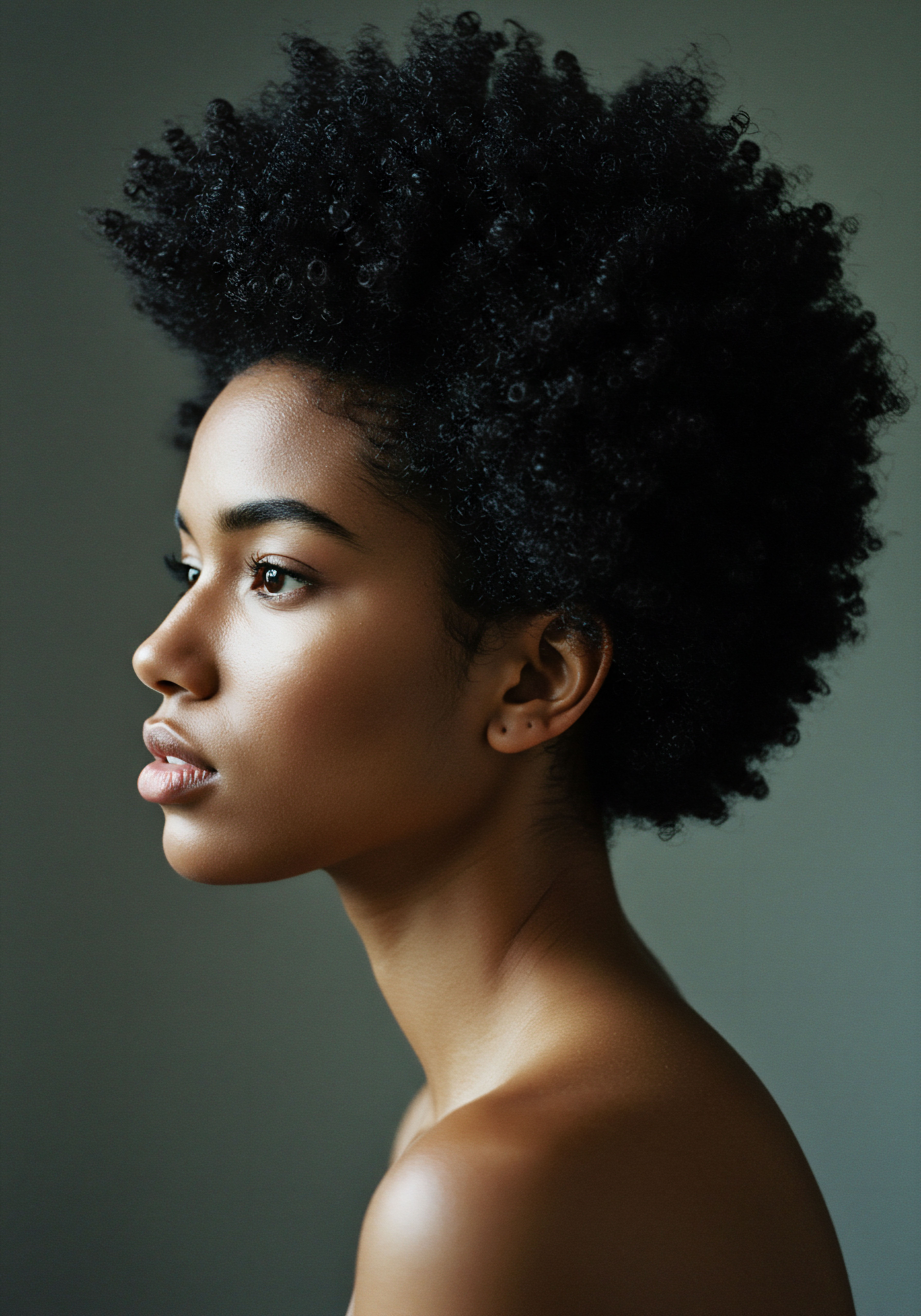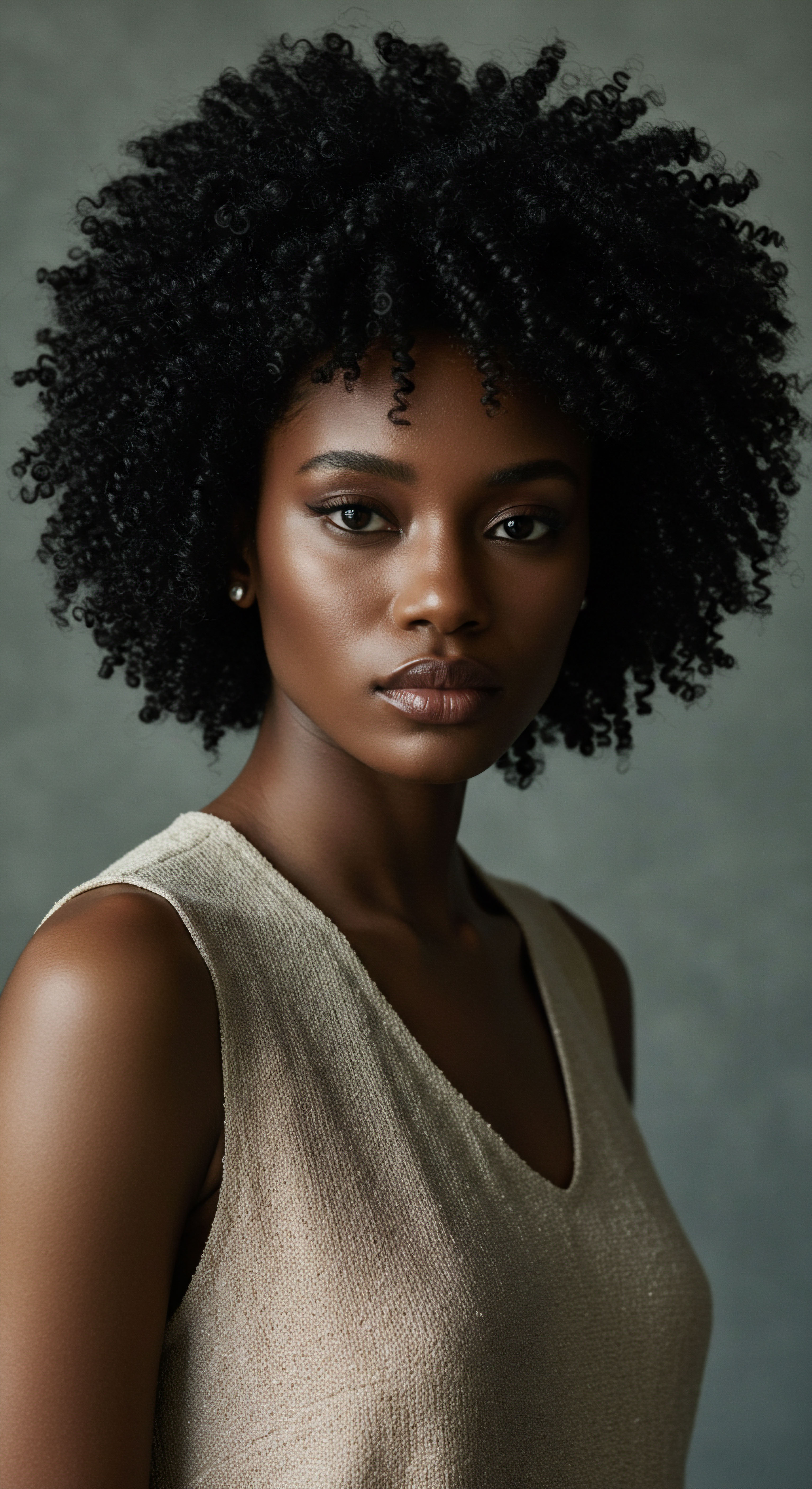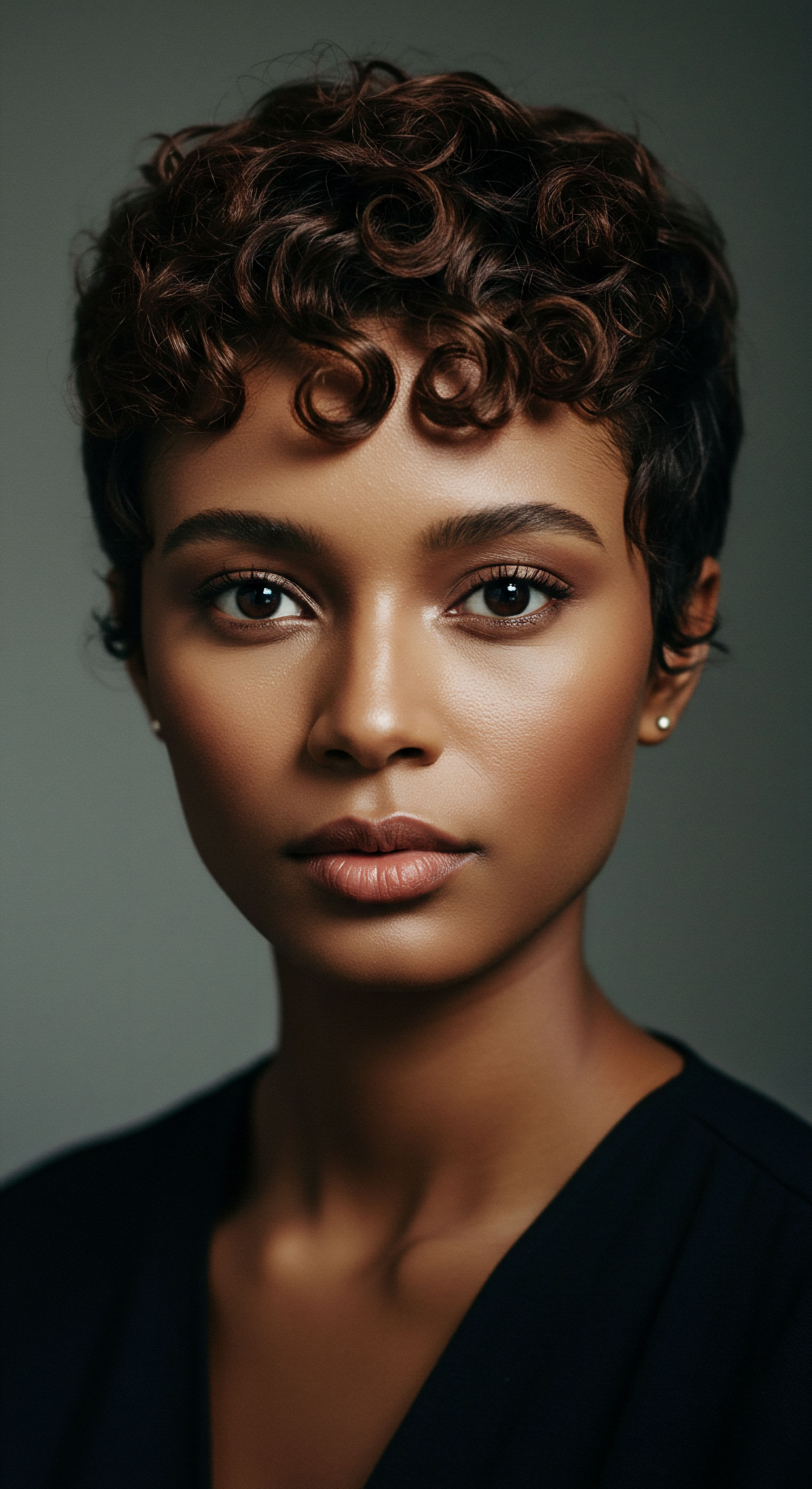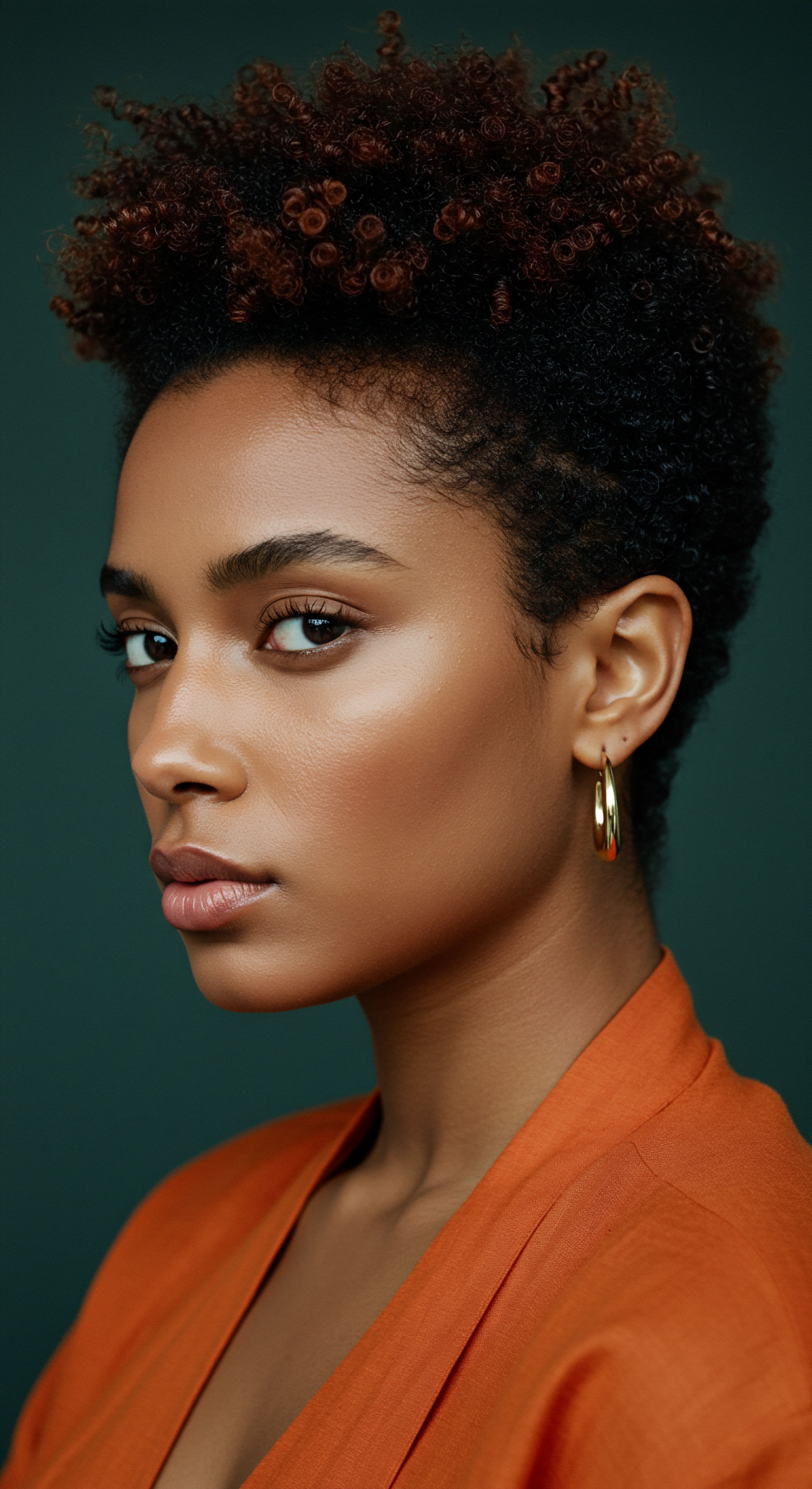
Roots
The quiet hum of life, often unnoticed, orchestrates countless processes within our bodies, from the subtle beat of our hearts to the gentle growth of each hair strand. For those with textured hair, a crown of unique spirals and coils, understanding these foundational rhythms holds a particular significance. It is within these deep, elemental connections that we begin to discern how something as seemingly distant as the quality of our slumber could touch the very essence of our hair’s vitality.
Our hair, far from a mere adornment, serves as a delicate barometer of our inner well-being, a visible expression of the harmony or discord within. It is a living extension, drawing its life from the very same wellspring that nourishes our entire being.

Hair Anatomy and Physiology’s Gentle Dance
At its core, hair growth is a cyclical wonder, a process guided by an intricate biological clock. Each hair follicle, a tiny organ nestled within the skin, embarks on a journey through distinct phases ❉ anagen, a period of vibrant growth; catagen, a brief transitional moment; and telogen, a resting phase before the gentle release of a strand makes way for new life. This rhythmic progression, unique to each individual follicle, prevents us from experiencing simultaneous shedding, ensuring a continuous canopy of hair.
For textured hair, this cycle is especially sensitive to disruptions, given its inherent structural qualities. The intricate twists and turns of these strands, while beautiful, also present points of vulnerability, making the foundational health of the follicle even more paramount.
Hair, a living extension of our inner harmony, draws its vitality from the same foundational rhythms that sustain our entire being.
The very architecture of textured hair, with its elliptical cross-section and varying degrees of curl, influences how nutrients travel along the hair shaft and how it responds to environmental factors. A robust anagen phase, where hair actively lengthens, relies on a steady supply of oxygen and essential nutrients delivered through healthy blood flow to the scalp. When this delicate system faces interruption, the hair’s natural growth trajectory can falter.

The Silent Language of Growth Cycles
Our bodies are a symphony of internal clocks, collectively known as the circadian rhythm. This biological timekeeper, attuned to the ebb and flow of light and darkness, governs far more than just our sleep and wakefulness. It influences cellular repair, hormone secretion, and even the pace at which our hair follicles grow. During the deep, restorative stages of sleep, particularly the non-REM phase, our body shifts into a mode of profound repair and regeneration.
This is when cell turnover accelerates, tissue repair takes place, and the levels of growth-promoting hormones, such as melatonin and growth hormone, naturally rise. These nocturnal activities are crucial for supporting the active growth phase of hair.
A significant body of research points to the circadian clock’s role in hair follicle activity. A study published in PNAS demonstrated that the local circadian clock within hair follicles generates a prominent daily mitotic rhythm, meaning hair cells proliferate faster in the morning than in the evening. This daily rhythmicity also affects how hair follicles respond to external stressors.
When this finely tuned system is disturbed, such as through inconsistent sleep patterns, the hair’s natural growth cycle can be shortened, potentially leading to slower growth or increased shedding over time. The whispers of our body’s internal clock truly echo in the vibrancy of our hair.

Ritual
As we move from the unseen rhythms of our biology to the tangible moments of our days and nights, we discover how intentional practices can cultivate a deeper connection to our hair’s well-being. The pursuit of serene strands extends beyond the products we choose; it encompasses the quiet, deliberate rituals that shape our daily existence, particularly those surrounding rest. For textured hair, which often demands a more mindful approach to care, these rituals are not simply routines, but acts of profound self-acknowledgment, honoring its unique structure and inherent needs.

Does Nighttime Neglect Invite Hair Thinning?
The hours of darkness, when the world quiets, offer a profound opportunity for renewal, not only for our minds and bodies but also for our hair. When sleep quality falters, the body’s repair mechanisms are compromised, and this can directly impact hair health. Insufficient sleep can elevate stress hormones like cortisol, which are known to disrupt the hair growth cycle and potentially hasten the transition of hair follicles into the resting, shedding phase known as telogen effluvium. This stress-induced shedding can be particularly noticeable for individuals with textured hair, where mechanical stress from styling or daily friction already poses a challenge.
Conscious nighttime rituals for textured hair are not mere routines, but acts of profound self-acknowledgment.
Consider the profound influence of a disturbed circadian rhythm, the body’s internal timekeeper. A 2014 study found a link between the consistency of circadian rhythm and the integrity of regenerated stem cell tissue. The prolonged disruption in tested animals’ sleep-wake cycles influenced hair follicles, suggesting a similar impact on human hair. When our natural rhythms are out of sync, the restorative processes that occur during sleep, including the crucial delivery of nutrients and oxygen to hair follicles, are impeded.

Protecting Your Crown Through Rest
For textured hair, protective nighttime styling and accessories are not merely suggestions; they are cornerstones of a regimen aimed at preserving length and density. The friction against pillows during sleep can lead to breakage, tangles, and dryness, especially for delicate curls and coils.
- Satin Bonnets ❉ A smooth, non-absorbent surface that minimizes friction and helps hair retain its natural moisture, preventing dryness and breakage.
- Silk Pillowcases ❉ An alternative to bonnets, silk provides a similar low-friction environment, allowing hair to glide rather than snag.
- Loose Braids ❉ Gently securing hair in a loose braid or twist reduces tangling and mechanical stress while sleeping, preserving curl definition.
These practices create a sanctuary for strands during the night, safeguarding them from environmental aggressors and the inevitable movement of sleep. By consciously preparing hair for rest, we extend the benefits of our daytime care, allowing the hair to thrive in a protected state. This deliberate act of preservation becomes a silent conversation with our hair, acknowledging its fragility and honoring its strength.
| Essential Satin Bonnet |
| Purpose Reduces friction |
| Benefit for Textured Hair Minimizes frizz, preserves moisture, prevents breakage |
| Essential Silk Pillowcase |
| Purpose Smooth surface |
| Benefit for Textured Hair Reduces snagging, lessens mechanical stress on delicate strands |
| Essential Loose Braids |
| Purpose Secures strands |
| Benefit for Textured Hair Prevents tangling, maintains curl pattern, reduces nocturnal manipulation |
| Essential Hydrating Mist |
| Purpose Adds moisture |
| Benefit for Textured Hair Combats overnight dryness, keeps hair supple and resilient |
| Essential These tools and techniques form a foundational shield for textured hair during restorative sleep. |

Relay
Moving beyond the visible and the ritualistic, we find ourselves in a deeper dialogue with the intricate biological and environmental currents that shape our hair’s journey. The connection between the quality of our sleep and the density of our hair is not a simple linear progression; it is a complex interplay of hormones, cellular processes, and the subtle yet profound influence of our internal biological clocks. Here, the wisdom of science converges with lived experience, offering a more complete understanding of how sleep’s disruptions can send ripples through our very being, ultimately reaching the delicate follicles that birth our strands.

How Do Hormonal Fluctuations From Poor Sleep Affect Hair Follicles?
Sleep, far from a passive state, is a dynamic period of hormonal regulation. When sleep patterns are consistently disturbed, the delicate balance of hormones that govern our body’s functions can be thrown into disarray. A prominent player in this hormonal symphony is Cortisol, often referred to as the stress hormone. Elevated levels of cortisol, a common consequence of chronic sleep deprivation, can signal to hair follicles to prematurely enter the telogen, or resting, phase.
This acceleration of the hair cycle can lead to excessive shedding, a condition known as telogen effluvium. This shedding, while often temporary, can result in a noticeable reduction in hair density.
Beyond cortisol, other hormones also play a significant role. Melatonin, widely recognized for its part in regulating sleep cycles, also directly influences hair follicle function. Research indicates that melatonin can prolong the anagen, or active growth, phase of hair and delay the onset of the catagen and telogen phases. A reduction in melatonin levels due to poor sleep could therefore hinder hair growth and contribute to thinning.
Furthermore, sleep influences the balance of thyroid hormones, estrogen, and testosterone, all of which have direct implications for hair health. Disruptions in these hormonal levels can manifest as changes in hair texture, growth rate, and overall density.

What Less Common Data Points Illuminate the Sleep-Hair Link?
While the general link between stress, sleep, and hair loss is acknowledged, certain less commonly discussed research avenues offer a deeper, sometimes unexpected, view into this relationship. Consider the impact of Shift Work, a pervasive modern reality that fundamentally disrupts natural circadian rhythms. A study published in Oxford Academic found that young shift workers (under 40 years of age) exhibited significantly higher levels of hair cortisol, a biomarker for long-term stress, compared to day workers. This persistent elevation of stress hormones, directly linked to a chronic misalignment with the body’s natural sleep-wake cycle, creates an environment conducive to hair thinning.
While the study itself did not directly measure hair loss in these individuals, the documented rise in cortisol provides a compelling physiological pathway through which chronic circadian disruption, inherent in shift work, could contribute to hair fragility and eventual loss. The continued stress response, measurable in hair cortisol, serves as a quiet alarm, signaling a potential for systemic imbalances that extend to follicular health.
Another compelling area of inquiry lies in the bidirectional relationship between sleep disorders and autoimmune conditions affecting hair. A systematic review revealed that individuals with alopecia areata (AA), an autoimmune disorder causing patchy hair loss, are at a significantly higher risk of developing obstructive sleep apnea and non-apneic insomnia. Conversely, patients with diagnosed sleep disorders were more prone to developing AA.
This suggests a complex feedback loop where sleep disturbances can trigger or exacerbate autoimmune responses, and the psychological burden of hair loss can, in turn, impair sleep quality, creating a cyclical challenge. This interplay underscores the body’s interconnectedness, where one system’s disquiet can echo throughout another.

Cultural Perspectives on Rest and Hair
Across diverse cultures, the relationship between rest, self-care, and hair health holds varying degrees of prominence. While modern Western perspectives often frame sleep as a biological necessity to be optimized for productivity, many traditional societies embed rest within a broader understanding of holistic well-being and spiritual connection. For some, hair is not merely a biological structure but a sacred extension of identity, lineage, and spiritual power.
In many African and diasporic cultures, the nighttime ritual for textured hair is steeped in practices that honor its delicate nature. The use of bonnets or wraps is not simply about preserving a hairstyle; it is a generational wisdom passed down to protect hair from environmental elements and maintain its health, reflecting a deep respect for the strands themselves. This contrasts sharply with cultural norms that might prioritize heat styling or chemical alterations, which can place immense stress on hair, particularly when coupled with inadequate rest.
The communal wisdom around sleep, whether explicitly linked to hair or implicitly through general well-being, offers a lens through which to appreciate the nuanced ways societies approach the care of self and, by extension, the care of hair. The understanding that hair flourishes when the individual is in a state of rest and balance is a truth that resonates across many cultural boundaries, regardless of how it is articulated.

Reflection
The journey through the subtle currents connecting our sleep to the vitality of our hair reveals a truth both profound and deeply personal ❉ our strands, with their unique textures and stories, are intimately tied to the quiet moments of our deepest rest. The quality of our slumber, far from a mere interlude, becomes a foundational pillar, supporting the very architecture of our hair’s growth and resilience. It is a gentle reminder that true beauty emanates from a place of inner harmony, a symphony of well-being where every note, even the silent ones of restorative sleep, plays a vital part in the vibrant expression of who we are. To tend to our hair, then, is to tend to ourselves, recognizing the inherent wisdom in allowing our bodies the sacred space to repair, renew, and quietly, beautifully, grow.

References
- Montagna, William. The Biology of Hair Growth. Academic Press, 1958.
- Paus, Ralf, and George Cotsarelis. “The Biology of Hair Follicles.” New England Journal of Medicine, vol. 341, no. 7, 1999, pp. 491-497.
- Harrison, Stephen, and Wilma Bergfeld. “Diffuse Hair Loss ❉ Its Triggers and Management.” Cleveland Clinic Journal of Medicine, vol. 76, no. 6, 2009, pp. 361-367.
- Manenschijn, Anne, et al. “Shift Work at Young Age Is Associated with Elevated Long-Term Cortisol Levels and Body Mass Index.” Oxford Academic, Journal of Clinical Endocrinology & Metabolism, vol. 97, no. 10, 2012, pp. 3696-3702.
- Kim, M. H. et al. “Risk of Alopecia Areata and Other Related Autoimmune Diseases in Patients with Sleep Disorders ❉ A Korean Population-Based Retrospective Cohort Study.” Oxford Academic, Journal of Clinical Endocrinology & Metabolism, vol. 103, no. 8, 2018, pp. 2977-2984.
- Li, M. et al. “Relationships Among Shift Work, Hair Cortisol Concentration and Sleep Disorders ❉ A Cross-Sectional Study in China.” BMJ Open, vol. 10, no. 11, 2020, pp. e039308.
- Oztekin, S. et al. “Sleep Disturbance in Alopecia Areata ❉ A Cross-Sectional Study.” Journal of Cosmetic Dermatology, vol. 21, no. 4, 2022, pp. 1656-1661.
- Al-Nuaimi, Yasmin, et al. “Melatonin and the Human Hair Follicle.” Journal of Drugs in Dermatology, vol. 22, no. 3, 2023, pp. 278-283.
- Li, M. et al. “Melatonin Regulates the Periodic Growth of Secondary Hair Follicles Through the Nuclear Receptor RORα.” Frontiers in Physiology, vol. 14, 2023.
- Dai, W. et al. “Two-Way Association Between Alopecia Areata and Sleep Disorders ❉ A Systematic Review of Observational Studies.” Cureus, vol. 15, no. 11, 2023, pp. e48967.
- Wong, Stephanie, and Raja Sivamani. “How Does the Circadian Rhythm Affect Hair Growth?” LearnSkin, 2017.
- Geyfman, Moshe, and Maksim V. Plikus. “Circadian Clock Genes Contribute to the Regulation of Hair Follicle Cycling.” PLoS Genetics, vol. 9, no. 5, 2013, pp. e1003318.
- Plikus, Maksim V. et al. “Local Circadian Clock Gates Cell Cycle Progression of Transient Amplifying Cells During Regenerative Hair Cycling.” Proceedings of the National Academy of Sciences, vol. 110, no. 21, 2013, pp. E1930-E1939.